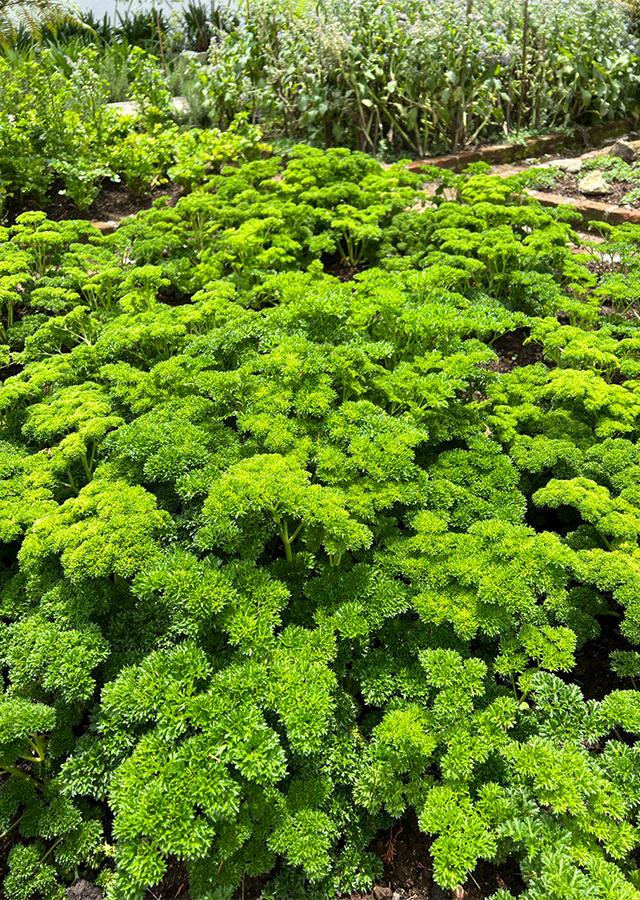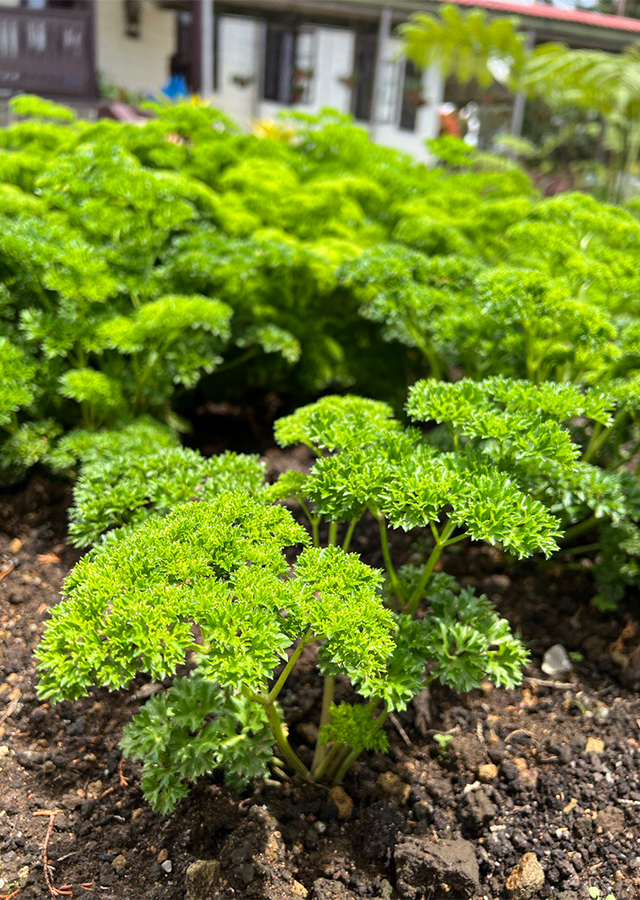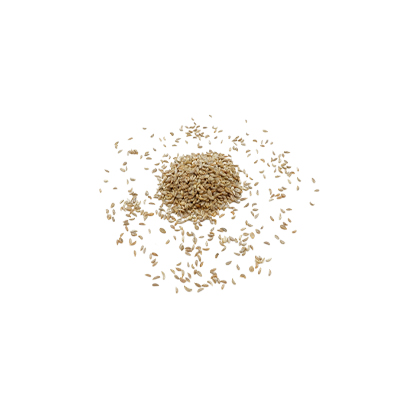Parsley
Petroselinum crispum (Mill.) Fuss
Apiaceae
Location in our garden
Vegetable



Synonym
Apium crispum Mill.
Habitus
Herbaceous. An erect, branched, biennial plant growing about 60 cm tall.
Part Used
Leaves
Seeds
Roots
The Whole Plant
Growing Requirements
Full Sunshine
Need Shade
Habitat
Terrestrial
Overview
Petroselinum crispum is believed to be originally grown in Sardinia (Mediterranean area) andwas cultivated from circa 3rd century BC. Linnaeus stated its wild habitat to be Sardinia, whence it was brought to England and apparently first cultivated in Britain in 1548; Bentham considered it a native of the Eastern Mediterranean regions; De Candolle of Turkey, Algeria and the Lebanon. Since its introduction into these islands in the sixteenth century it has been completely naturalized in various parts of England and Scotland. Parsley is one of the most popular of culinary herbs, it is commonly cultivated for its edible leaves and also has a range of medicinal and other uses. The fresh leaves are highly nutritious and can be considered a natural vitamin and mineral supplement. Very rich in iron, iodine and magnesium, and is also a good source of other minerals and the vitamins A, B and C. It is frequently used as a garnish or as a flavouring in salads and many cooked dishes. The stems can be dried and ground and used as a food colouring. A tea is made from the fresh or dried leaves. An essential oil obtained from the plant is used in perfumeries.
Vernacular Names
Perejil (Spanish), Persil (French), Salsa (Portuguese), Petroselino (Italian), Petersilie (German), Persilja (Swedish), Vannsuy baraing (Cambodian), Phakchi-farang (Thailand).
Agroecology
Found in grassy waste places on walls and rocks, especially on limestone and near the coast. A plant of the temperate zone, it can also be cultivated in the subtropics and tropics. Parsley, particularly the more upright forms, grows reasonably well at low elevations in the tropics, though better crops are generally obtained at elevations above 600 m. It grows best in areas where annual daytime temperatures are within the range 11-20 °C, but can tolerate 7-28 °C. When dormant, the plant can survive temperatures down to about -5 °C, but young growth can be severely damaged at 0 °C. It prefers a mean annual rainfall in the range 900-1,500 mm, but tolerates 300-2,800 mm. Prefers a moist well-drained soil in sun or partial shade. High temperatures can adversely affect growth, so light shade is often helpful. Prefers a good light soil that is not too light or acid, growing poorly in light acid soils. Tolerant of a moderate level of salt in the soil. Prefers a pH in the range 6-7.5, tolerating 5.3-8.3.
Morphology
- Root - slender, fibrous with taproot measures up to 1 m long, sometimes thickened.
- Stem - cylindrical, grooved and hollow.
- Leaves - forms a rosette of tripinnate leaves with numerous leaflets, arranged alternately, 1-3-pinnately compound, dark green, glossy, flat or curled and with sheath at the base. The petiole is longest in the lower leaves. The pinnae are long-stalked, with obovate-cuneate to finely linear leaflets, which are divided into acute segments. The higher leaves aregradually less divided while the topmost leaf consists of a few acute segments only.
- Flowers - flat-topped diameter umbels with numerous yellow to yellowish-green flowers, inflorescence is a terminal or axillary compound umbel. The 1-3 foliolate bracts are rather short. There are 3 to 15 secondary rays (pedicels) which are 2 to 5 mm long. The flowers are small, yellow-green and bisexual. The sepal is obscure. The petal consists of 5petals which are sub-orbicular to obovate, measuring up to 1 mm x 0.5 mm and sub-marginate with an inflexed apical lobe. There are 5 stamens. The pistil is with an inferior and2-carpelled ovary where each carpel is with a thickened stylopodium, a style and a spherical stigma.
- Fruit - a schizocarp, measuring 2 to 3 mm long, ovoid and it splits into 2 mericarps when ripen with each having 5 narrow ribs.
- Seeds - ovoid, 2 to 3 mm long, with prominent style remnants at the apex. The plant normally dies after seed maturation.
Cultivation
- Generatively propagated by seed - sow in containers or a seedbed and plant out when about 10 cm tall.
- Germination usually takes place in about 7 days at 25 °C, though it can take 4-6 weeks.
- Germination time can be reduced by pre-soaking the seed for 12 hours in hot water that is allowed to cool quickly, but be careful not to overdo the heat and cook the seed.
- The seed remains viable in normal storage for 2-3 years.
Chemical Constituents
Phenolic acids (caffeic, chlorogenic, and ferulic acids), flavonoids (apigenin, kaempferol, catechin), essential oils (myristicin,coumarin, apiole).
Traditional Medicinal Uses
- The plants prime use is as a diuretic where it is effective in ridding the body of stones and in treating jaundice, dropsy, cystitis etc. It is also a good detoxifier, helping the body to get rid of toxins via the urine and therefore helping in the treatment of a wide range of diseases such as rheumatism.
- Parsley is antidandruff, antispasmodic, aperient, carminative, digestive, diuretic, emmenagogue, expectorant, galactofuge, kidney, stomachic and tonic. An infusion of the roots and seeds is taken after childbirth to promote lactation and help contract the uterus. Parsley is also a mild laxative and is useful for treating anaemia and convalescents.
- A poultice of the leaves has been applied externally to soothe bites and stings, it is also said to be of value in treating tumours of a cancerous nature.
- It has been used to treat eye infections, whilst a wad of cotton soaked in the juice will relieve toothache or earache. It is also said to prevent hair loss and to make freckles disappear.
Part Used
Reference Sources
- Agyare, C.,et al. (2017). Petroselinum crispum: A Review. Medicinal Spices and Vegetables from Africa (pp.527-547. DOI:10.1016/B978-0-12-809286-6.00025-X. Also available: https://www.researchgate.net/publication/312689368_Petroselinum_crispum_A_Review.
- CAB International. (2022). Petroselinum crispum (parsley). https://www.cabi.org/isc/datasheet/38808. 22-04-2022.
- Fern, Ken. (2021). Useful Tropical Plants: Petroselinum crispum. https://tropical.theferns.info/viewtropical.php?id=Petroselinum+crispum. 22-04-2022.
- Ferreira, F.S., et al. (2022). Bioactive compounds of parsley (Petroselinum crispum), chives (Allium schoenoprasum L) and their mixture (Brazilian cheiro-verde) as promising antioxidant and anti-cholesterol oxidation agents in a food system. Food Research International. Vol.151. Also available: https://www.sciencedirect.com/science/article/abs/pii/S096399692100764X.
- Kew Royal Botanic Gardens. (No date). Plants of the world Online: Petroselinum crispum (Mill.) Fuss https://powo.science.kew.org/taxon/urn:lsid:ipni.org:names:60442790-2. 22-04-2022.
- Plants For A Future. (2022). Petroselinum crispum tuberosum - (Bernh.)Crov.. https://pfaf.org/user/Plant.aspx?LatinName=Petroselinum+crispum+tuberosum. 22-04-2022.



